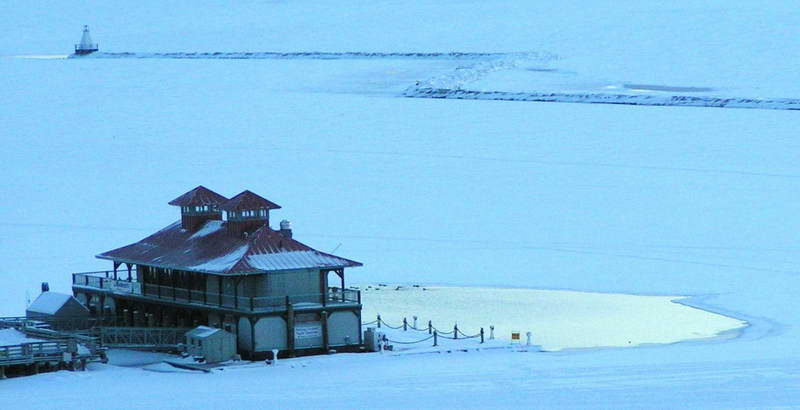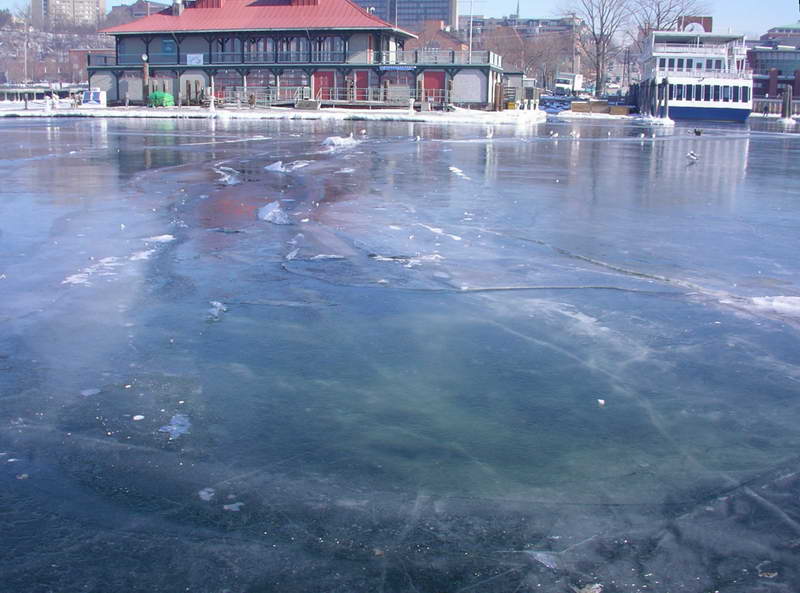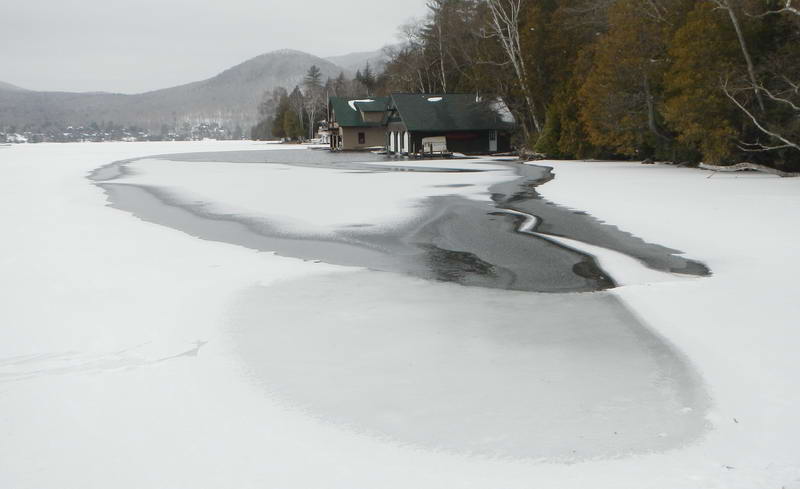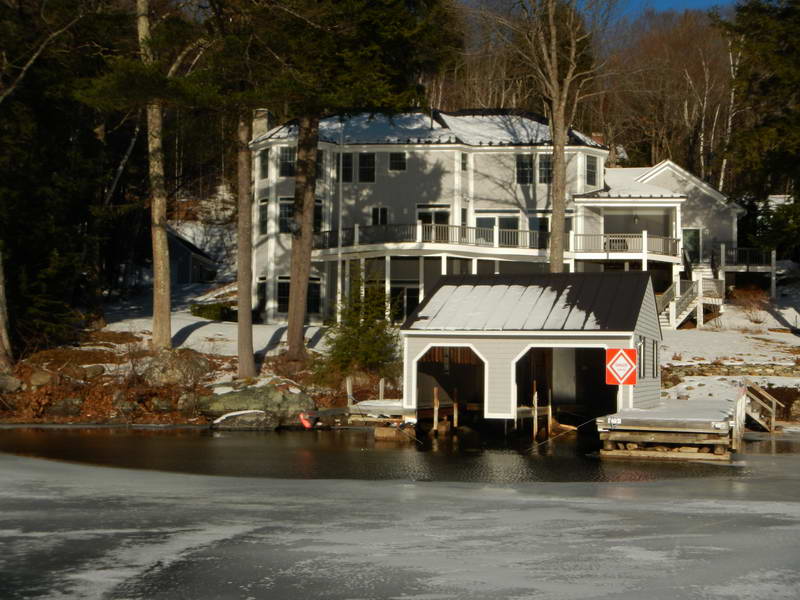 Burlington Boathouse (a few years ago) with de-icers keeping the water open on the lake side.
Burlington Boathouse (a few years ago) with de-icers keeping the water open on the lake side.
Dock Bubblers and De-icers
Ice can exert considerable pressure on the shoreline from thermal expansion, high wind on large ice sheets and collisions of large ice floes. Docks and boats are usually not built to withstand the forces that ice can impose on them. Many years ago someone figured out that pumping air into the water at the edge of docks and boats would keep the ice melted with the flow of above freezing water bought up by the bubbles. More recently, more efficient underwater propellers type de-icers have become popular. All this is great for docks and boats but they present problems for ice users.
 A propeller deicer keeps this water open on Lake Placid NY
A propeller deicer keeps this water open on Lake Placid NY
When comming off the ice, any dock should be approached as though it has open water around it. If the main ice sheet is thick it will probably be thick within 50 feet or less of the open water but giving docks and bubblers a wide berth is the prudent thing to do. Adjacent de-icers may have thin ice areas between them. If they are aimed at an angle to the surface where they have much more lateral reach and can create thin ice further away. They are often shut off to save electricity and the open water will often skin over during cold conditions. If the main ice sheet is black ice, this thin ice may look similar to the thicker main sheet. If you do approach a dock, check carefully to see if it has any evidence of having a de-icer and use with your test pole (or drill) a lot.
 The far end of a folded ridge that orginated at the open water in front of the Burlington Boathouse. The water over the down folded ice sheet is several feet deep in the foreground.
The far end of a folded ridge that orginated at the open water in front of the Burlington Boathouse. The water over the down folded ice sheet is several feet deep in the foreground.
Another problem is caused by having a section of open water along the perimeter of an ice sheet. The expansion pressure in the ice pushes on the shore on either side of the de-iced section and has nothing to push on where there is open water. The ice tends to move toward the lack of resistance. This can result in a folded ridge that extends out into the ice sheet as shown in the above picture.
In 2005 a good friend's dog fell into the open water from the de-icer in front of the Burlington Boat House. He broke through in trying to retrive the dog. Click here for the full story.
 Lateral melting and thinning can extend a considerable distance from the de-icers. In this case, a shallow fold down ridge may be contributing.
Lateral melting and thinning can extend a considerable distance from the de-icers. In this case, a shallow fold down ridge may be contributing.
Issues with de-icing
Some people think of docks as a good place get off the ice (and this is often the case if there is no de-icer present). Even when people are expecting that some docks are de-iced it can be hard to predict where and when there will be thin ice.
Ray Ford wrote an excellent article called Trouble in bubbler land in the October 2012 edition of, Canadian publication, Cottage Life. Ray outlines the practical and legal issues associated with having a bubbler/de-icer. If you have or are considering having a de-icer his article is important reading. (see links 1 and 1a below).
In Ray's article, there are a bunch of suggestions for 'minding the gap'. In particular, contributor Jim Boys discusses how to keep the gap within a few inches of the dock. My observation on Lake Placid (NY) last winter was that many of the de-icers were melting much more ice than was needed and sometimes creating thin ice fairly far from the open water. This was no place to be without a test pole and a properly equiped buddy near by.
Various methods have been used to warn about the hazard:
- Blinking yellow lights on the dock or the ice (Ray's article points out that red is a bad choice for lights as it is too easily confused with snowmobile tail lights in low visiblity conditions).
- Various fence like arrangements (see Ray's article for more info).
- Signs on the ice
- A line of Christmas trees beyond the thin ice
- Cones or other markers beyond the thin ice.
- Large signs on the dock
- If a folded ridge develops from your de-iced area, you might consider marking that to.
Potential shortcomings: Signs or other markers on the ice need to be close enough together that they are hard to miss. They can be difficult to keep standing in a thaw. Large signs on the dock need to be big enough to get people's attention. Christmas trees are good markers but they often end up elsewhere around the lake after the ice melts or they blow away after tipping over in a windy thaw. In my view, any of these precautions are worth taking. Obviously, if you go out on the ice to place signs, trees or markers, be properly equipped (claws, test pole, throw rope,lifejacket, buddy, etc) and know how to rescue yourself or others in case you find yourself on ice that is too thin.

A 'DANGER Thin Ice' sign on a deiced boat house on Lake Sunapee in New Hampshire.
A similar hazard to de-icers exists in lakes that have aeration systems. These are typically put in small, shallow lakes to preserve a healthy fish populations. These lakes are usually marked with signs. More..
Link 1: For a copy of October 2012 issue of Cottage Life go to the Cottage Life publisher page. Look for the 'View back issues>>' link on the middle right side. On the next page select the image of the October 2012 issue and go from there. The current price is $4.70.
Link 1a: google: 'trouble in bubbler land' to find a PDF of the article text.
Link 3: Lake George Association Winter 2008 newsletter -discussion of managing ice around docks (see the second page)
Link 3A: Don't be Eaten Alive!: De-icing 101 from the Lake George Association. This is a practical overview of how to protect docks and reduce the risk to ice users.
Link 4): Swartswood Lakes & Watershed Association, January 2011 Newsletter: On page 5 there are some comments about life safety issues associated Ice-Eaters (propeller type de-icers)
Link 5 Ice Eaters Regulations for Lake Hopatcong (NJ)
Link 5A) some New Jersey township ordiences related to ice-retardant systems.
Link 6) A February 2012 article in Cottage Life by Blair Eveleigh
Bob-updated 9/13/2013
